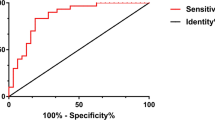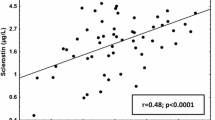Abstract
Osteocytes play a central role in the regulation of bone remodeling. The aim of this study was to explore osteocyte function, and particularly the expression of SOST, a Wnt inhibitor, in patients with hip fractures. Serum sclerostin levels were measured by ELISA. The expression of several osteocytic genes was studied by quantitative PCR in trabecular samples of the femoral head of patients with hip fractures, hip osteoarthritis and control subjects. The presence of sclerostin protein and activated caspase 3 was revealed by immunostaining. There were no significant differences in serum sclerostin between the three groups. Patients with fractures have fewer lacunae occupied by osteocytes (60 ± 5% vs. 64 ± 6% in control subjects, P = 0.014) and higher numbers of osteocytes expressing activated caspase 3, a marker of apoptosis. The proportion of sclerostin-positive lacunae was lower in patients with fractures than in control subjects (34 ± 11% vs. 69 ± 10%, P = 2 × 10−8). The proportion of sclerostin-positive osteocytes was also lower in patients. RNA transcripts of SOST, FGF23 and PHEX were also less abundant in fractures than in control bones (P = 0.002, 5 × 10−6, and 0.04, respectively). On the contrary, in patients with osteoarthritis, there was a decreased expression of SOST and FGF23, without differences in PHEX transcripts or osteocyte numbers. Osteocyte activity is altered in patients with hip fractures, with increased osteocyte apoptosis and reduced osteocyte numbers, as well as decreased transcription of osteocytic genes. Therefore, these results suggest that an osteocyte deficiency may play a role in the propensity to hip fractures.





Similar content being viewed by others
References
Komatsu DE, Mary MN, Schroeder RJ, Robling AG, Turner CH, Warden SJ (2010) Modulation of Wnt signaling influences fracture repair. J Orthop Res 28:928–936
Moester MJ, Papapoulos SE, Lowik CW, van Bezooijen RL (2010) Sclerostin: current knowledge and future perspectives. Calcif Tissue Int 87:99–107
Gaur T, Lengner CJ, Hovhannisyan H, Bhat RA, Bodine PV, Komm BS, Javed A, van Wijnen AJ, Stein JL, Stein GS, Lian JB (2005) Canonical WNT signaling promotes osteogenesis by directly stimulating Runx2 gene expression. J Biol Chem 280:33132–33140
Johnson ML, Harnish K, Nusse R, Van Hul W (2004) LRP5 and Wnt signaling: a union made for bone. J Bone Miner Res 19:1749–1757
Bonewald LF (2011) The amazing osteocyte. J Bone Miner Res 26:229–238
Rochefort GY, Pallu S, Benhamou CL (2010) Osteocyte: the unrecognized side of bone tissue. Osteoporos Int 21:1457–1469
Dallas SL, Bonewald LF (2010) Dynamics of the transition from osteoblast to osteocyte. Ann NY Acad Sci 1192:437–443
Velasco J, Zarrabeitia MT, Prieto JR, Perez-Castrillon JL, Perez-Aguilar MD, Perez-Nunez MI, Sanudo C, Hernandez-Elena J, Calvo I, Ortiz F, Gonzalez-Macias J, Riancho JA (2010) Wnt pathway genes in osteoporosis and osteoarthritis: differential expression and genetic association study. Osteoporos Int 21:109–118
Hernandez JL, Garcés CM, Sumillera M, Fernandez-Aldasoro EV, Garcia-Ibarbia C, Ortiz JA, Arozamena J, Alonso MA, Riancho JA (2008) Aromatase expression in osteoarthritic and osteoporotic bone. Arthritis Rheum 58:1696–1700
Li X, Zhang Y, Kang H, Liu W, Liu P, Zhang J, Harris SE, Wu D (2005) Sclerostin binds to LRP5/6 and antagonizes canonical Wnt signaling. J Biol Chem 280:19883–19887
Poole KE, van Bezooijen RL, Loveridge N, Hamersma H, Papapoulos SE, Lowik CW, Reeve J (2005) Sclerostin is a delayed secreted product of osteocytes that inhibits bone formation. FASEB J 19:1842–1844
Veverka V, Henry AJ, Slocombe PM, Ventom A, Mulloy B, Muskett FW, Muzylak M, Greenslade K, Moore A, Zhang L, Gong J, Qian X, Paszty C, Taylor RJ, Robinson MK, Carr MD (2009) Characterization of the structural features and interactions of sclerostin: molecular insight into a key regulator of Wnt-mediated bone formation. J Biol Chem 284:10890–10900
Loots GG, Kneissel M, Keller H, Baptist M, Chang J, Collette NM, Ovcharenko D, Plajzer-Frick I, Rubin EM (2005) Genomic deletion of a long-range bone enhancer misregulates sclerostin in Van Buchem disease. Genome Res 15:928–935
Li X, Ominsky MS, Warmington KS, Morony S, Gong J, Cao J, Gao Y, Shalhoub V, Tipton B, Haldankar R, Chen Q, Winters A, Boone T, Geng Z, Niu QT, Ke HZ, Kostenuik PJ, Simonet WS, Lacey DL, Paszty C (2009) Sclerostin antibody treatment increases bone formation, bone mass, and bone strength in a rat model of postmenopausal osteoporosis. J Bone Miner Res 24:578–588
Padhi D, Jang G, Stouch B, Fang L, Posvar E (2011) Single-dose, placebo-controlled, randomized study of AMG 785, a sclerostin monoclonal antibody. J Bone Miner Res 26:19–26
Cardoso L, Herman BC, Verborgt O, Laudier D, Majeska RJ, Schaffler MB (2009) Osteocyte apoptosis controls activation of intracortical resorption in response to bone fatigue. J Bone Miner Res 24:597–605
Verborgt O, Gibson GJ, Schaffler MB (2000) Loss of osteocyte integrity in association with microdamage and bone remodeling after fatigue in vivo. J Bone Miner Res 15:60–67
Clark WD, Smith EL, Linn KA, Paul-Murphy JR, Muir P, Cook ME (2005) Osteocyte apoptosis and osteoclast presence in chicken radii 0–4 days following osteotomy. Calcif Tissue Int 77:327–336
Power J, Parker M, Papapoulos S, Van Bezooijen R, Reeve J, Loveridge N (2011) Osteocytic sclerostin expression is locally reduced at the site of femoral neck fracture (abstract). Bone 48(suppl 2):S168
Tatsumi S, Ishii K, Amizuka N, Li M, Kobayashi T, Kohno K, Ito M, Takeshita S, Ikeda K (2007) Targeted ablation of osteocytes induces osteoporosis with defective mechanotransduction. Cell Metab 5:464–475
Watanabe K, Ikeda K (2010) Osteocytes in normal physiology and osteoporosis. Clin Rev Bone Miner Metab 8:224–232
Zarrinkalam MR, Mulaibrahimovic A, Atkins GJ, Moore RJ (2011) Changes in osteocyte density correspond with changes in osteoblast and osteoclast activity in an osteoporotic sheep model. Osteoporos Int [Epub ahead of print]
Irie K, Ejiri S, Sakakura Y, Shibui T, Yajima T (2008) Matrix mineralization as a trigger for osteocyte maturation. J Histochem Cytochem 56:561–567
Bellido T (2006) Downregulation of SOST/sclerostin by PTH: a novel mechanism of hormonal control of bone formation mediated by osteocytes. J Musculoskelet Neuronal Interact 6:358–359
Leupin O, Kramer I, Collette NM, Loots GG, Natt F, Kneissel M, Keller H (2007) Control of the SOST bone enhancer by PTH using MEF2 transcription factors. J Bone Miner Res 22:1957–1967
Silvestrini G, Ballanti P, Leopizzi M, Sebastiani M, Berni S, Di Vito M, Bonucci E (2007) Effects of intermittent parathyroid hormone (PTH) administration on SOST mRNA and protein in rat bone. J Mol Histol 38:261–269
Papanicolaou SE, Phipps RJ, Fyhrie DP, Genetos DC (2009) Modulation of sclerostin expression by mechanical loading and bone morphogenetic proteins in osteogenic cells. Biorheology 46:389–399
Robling AG, Niziolek PJ, Baldridge LA, Condon KW, Allen MR, Alam I, Mantila SM, Gluhak-Heinrich J, Bellido TM, Harris SE, Turner CH (2008) Mechanical stimulation of bone in vivo reduces osteocyte expression of Sost/sclerostin. J Biol Chem 283:5866–5875
Gregson C, Poole K, Steel C, Ayuk J, McCloskey E, Fraser W, Tobias J (2011) Elevated sclerostin levels in individuals with high bone mass (abstract). Bone 48(suppl 2):S71–S72
Fisher A, Srikusalanukul W, Davis M, Smith P (2010) Hip fracture type: important role of parathyroid hormone (PTH) response to hypovitaminosis D. Bone 47:400–407
Mirza FS, Padhi ID, Raisz LG, Lorenzo JA (2010) Serum sclerostin levels negatively correlate with parathyroid hormone levels and free estrogen index in postmenopausal women. J Clin Endocrinol Metab 95:1991–1997
Polyzos SA, Anastasilakis AD, Bratengeier C, Woloszczuk W, Papatheodorou A, Terpos E (2011) Serum sclerostin levels positively correlate with lumbar spinal bone mineral density in postmenopausal women—the six-month effect of risedronate and teriparatide. Osteoporos Int [Epub ahead of print]
Modder UI, Hoey KA, Amin S, McCready LK, Achenbach SJ, Riggs BL, Melton LJ III, Khosla S (2011) Relation of age, gender, and bone mass to circulating sclerostin levels in women and men. J Bone Miner Res 26:373–379
Rhee Y, Bivi N, Farrow E, Lezcano V, Plotkin LI, White KE, Bellido T (2011) Parathyroid hormone receptor signaling in osteocytes increases the expression of fibroblast growth factor-23 in vitro and in vivo. Bone [Epub ahead of print]
Lavi-Moshayoff V, Wasserman G, Meir T, Silver J, Naveh-Many T (2010) PTH increases FGF23 gene expression and mediates the high-FGF23 levels of experimental kidney failure: a bone parathyroid feedback loop. Am J Physiol Renal Physiol 299:F882–F889
Power J, Poole KE, Van Bezooijen R, Doube M, Caballero-Alias AM, Lowik C, Papapoulos S, Reeve J, Loveridge N (2010) Sclerostin and the regulation of bone formation: effects in hip osteoarthritis and femoral neck fracture. J Bone Miner Res 25:1867–1876
Qiu S, Rao DS, Palnitkar S, Parfitt AM (2003) Reduced iliac cancellous osteocyte density in patients with osteoporotic vertebral fracture. J Bone Miner Res 18:1657–1663
Qiu S, Rao DS, Palnitkar S, Parfitt AM (2006) Differences in osteocyte and lacunar density between black and white American women. Bone 38:130–135
Patsch JM, Kohler T, Berzlanovich A, Muschitz C, Bieglmayr C, Roschger P, Resch H, Pietschmann P (2011) Trabecular bone microstructure and local gene expression in iliac crest biopsies of men with idiopathic osteoporosis. J Bone Miner Res 26:1584–1592
Appel H, Ruiz-Heiland G, Listing J, Zwerina J, Herrmann M, Mueller R, Haibel H, Baraliakos X, Hempfing A, Rudwaleit M, Sieper J, Schett G (2009) Altered skeletal expression of sclerostin and its link to radiographic progression in ankylosing spondylitis. Arthritis Rheum 60:3257–3262
Acknowledgments
We acknowledge the excellent technical assistance of Carolina Sañudo. We thank Tecomedical Inc. for providing the ELISA kits to measure serum sclerostin. This work was supported by a grant from Instituto de Salud Carlos III/Fondo de Investigaciones Sanitarias (FIS 09/0539). JD-C is recipient of a grant from IFIMAV.
Author information
Authors and Affiliations
Corresponding author
Additional information
Delgado-Calle, González-Macías, and Riancho have received funding from Amgen. All other authors have stated that they have no conflict of interest.
Rights and permissions
About this article
Cite this article
Delgado-Calle, J., Arozamena, J., García-Renedo, R. et al. Osteocyte Deficiency in Hip Fractures. Calcif Tissue Int 89, 327–334 (2011). https://doi.org/10.1007/s00223-011-9522-0
Received:
Accepted:
Published:
Issue Date:
DOI: https://doi.org/10.1007/s00223-011-9522-0




